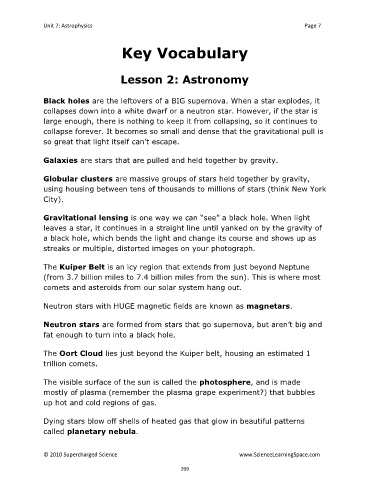Page 209 - Microsoft Word - LessonPlan-Overview.doc
P. 209
Unit 7: Astrophysics Page 7
Key Vocabulary
Lesson 2: Astronomy
Black holes are the leftovers of a BIG supernova. When a star explodes, it
collapses down into a white dwarf or a neutron star. However, if the star is
large enough, there is nothing to keep it from collapsing, so it continues to
collapse forever. It becomes so small and dense that the gravitational pull is
so great that light itself can’t escape.
Galaxies are stars that are pulled and held together by gravity.
Globular clusters are massive groups of stars held together by gravity,
using housing between tens of thousands to millions of stars (think New York
City).
Gravitational lensing is one way we can “see” a black hole. When light
leaves a star, it continues in a straight line until yanked on by the gravity of
a black hole, which bends the light and change its course and shows up as
streaks or multiple, distorted images on your photograph.
The Kuiper Belt is an icy region that extends from just beyond Neptune
(from 3.7 billion miles to 7.4 billion miles from the sun). This is where most
comets and asteroids from our solar system hang out.
Neutron stars with HUGE magnetic fields are known as magnetars.
Neutron stars are formed from stars that go supernova, but aren’t big and
fat enough to turn into a black hole.
The Oort Cloud lies just beyond the Kuiper belt, housing an estimated 1
trillion comets.
The visible surface of the sun is called the photosphere, and is made
mostly of plasma (remember the plasma grape experiment?) that bubbles
up hot and cold regions of gas.
Dying stars blow off shells of heated gas that glow in beautiful patterns
called planetary nebula.
© 2010 Supercharged Science www.ScienceLearningSpace.com
209

